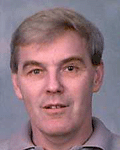
Biographical Note
 Dr. Richard Henderson was originally a physicist from Edinburgh University but switched into molecular biology at age 21. He went as a research student to the MRC Laboratory of Molecular Biology (LMB) in Cambridge, UK where he joined the team led by David Blow that worked out the atomic structure of the enzyme chymotrypsin, one of the first few protein structures to be determined using X-ray crystallography. He went on as a Helen Hay Whitney postdoctoral fellow at Yale University to develop an interest in the structure of membrane proteins, working for a few years on voltage dependent ion channels. After returning to LMB in 1973, he began to collaborate with Nigel Unwin and together they developed electron microscopy into a tool for the direct determination of the structure of proteins, and applied it most notably to the light-driven proton pump, bacteriorhodopsin, from Halobacteria. During the next 15 years, he worked to solve a number of the technical and conceptual problems which limited the attainable resolution of electron crystallography and by 1990, he and his colleagues had succeeded in obtaining the first atomic structure of the membrane protein, bacteriorhodopsin, by using electron microscopy and diffraction. Subsequent analysis of the structure of some of its photochemical intermediates has helped to understand how bacteriorhodopsin and other closely related family members function. Now 64 years old (in 2009), he has turned his attention to single particle electron microscopy where more advanced electron cryomicroscopy now offers the promise of being able to determine atomic structures of large protein assemblies without the need first to make crystals. These methods are now being used to solve many of the outstanding problems in structural biology.
Dr. Richard Henderson was originally a physicist from Edinburgh University but switched into molecular biology at age 21. He went as a research student to the MRC Laboratory of Molecular Biology (LMB) in Cambridge, UK where he joined the team led by David Blow that worked out the atomic structure of the enzyme chymotrypsin, one of the first few protein structures to be determined using X-ray crystallography. He went on as a Helen Hay Whitney postdoctoral fellow at Yale University to develop an interest in the structure of membrane proteins, working for a few years on voltage dependent ion channels. After returning to LMB in 1973, he began to collaborate with Nigel Unwin and together they developed electron microscopy into a tool for the direct determination of the structure of proteins, and applied it most notably to the light-driven proton pump, bacteriorhodopsin, from Halobacteria. During the next 15 years, he worked to solve a number of the technical and conceptual problems which limited the attainable resolution of electron crystallography and by 1990, he and his colleagues had succeeded in obtaining the first atomic structure of the membrane protein, bacteriorhodopsin, by using electron microscopy and diffraction. Subsequent analysis of the structure of some of its photochemical intermediates has helped to understand how bacteriorhodopsin and other closely related family members function. Now 64 years old (in 2009), he has turned his attention to single particle electron microscopy where more advanced electron cryomicroscopy now offers the promise of being able to determine atomic structures of large protein assemblies without the need first to make crystals. These methods are now being used to solve many of the outstanding problems in structural biology.
He was Joint-Head of the Division of Structural Studies at the MRC Laboratory of Molecular Biology from 1986 until 2001, and has been Director from 1996 to 2006. The Laboratory now houses about 350 scientists in four Divisions working on a wide range of problems in neurobiology, cell biology, structural biology, immunology, cancer biology and biotechnology. LMB also continues to develop techniques and methods alongside tackling challenging new scientific problems.
He is a fellow of the Royal Society and a Foreign Associate of the US National Academy of Sciences.